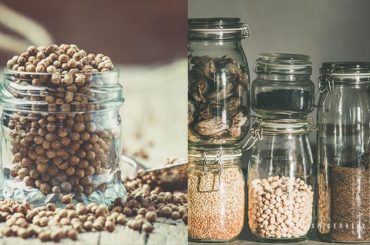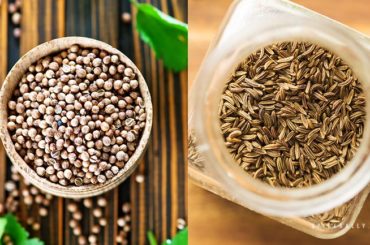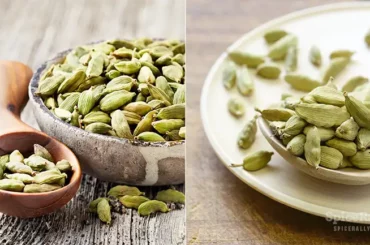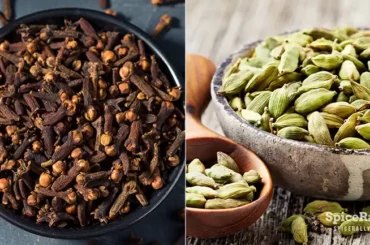Coriander and celery may not be getting confused when taken as whole plants. But, who could guarantee that the leaves of these two plants won’t get confused? And, most of you may have experienced this when shopping for herbs. In fact, there are notable differences between coriander vs celery.
Celery and coriander both belong to the same botanical family. Although coriander leaves (cilantro) and celery leaves look so much alike, they also have slight differences. Plus, the flavor, aroma, and usage of these two herbs differ too.
Accordingly, the primary intention of this article is to elaborate on the differences and similarities between cilantro (coriander leaves) and celery leaves. We think that is where most of you get confused.
And, to avoid any further complications and gather worldly knowledge on these two distinctive herbs, make sure you read till the end.
Coriander Vs Celery- What’s The Actual Difference?
Many home cooks and chefs across the globe use coriander leaves (cilantro) and celery with their dishes as two crispy, fresh, and aromatic herbs. Indeed, they give the perfect touch of greenery to any recipe they are called for.

As stated in our intro, cilantro and celery leaves share the same botanical family bond. And, the leaves resemble each other and are often confused. But, still, they have a few appearance differences. Despite the shape resemblance, they are also distinctive in flavor, aroma, nutrition, and many other features.
Consequently, the table below will explain the similarities and differences between coriander and celery. You will eventually realize their variations when sifting through the table, although they start with the same letter and come from the same family.
| Coriander Leaves (Cilantro) | Celery Leaves | |
|---|---|---|
| Flavor Profile | Citrusy, nuanced, and pungent with a fresh bite. (Soapy tasting to some) | Mildly pungent, fibrous, earthy, herbaceous with bitter and salty hints (more like the taste of parsley). Outer leaves are more intensely flavored. |
| Fragrance Profile | Somewhat citrusy, earthy, refreshing (soapy smelling to some) | It has a powerful and pleasant aroma and smells more like anise and fennel. And, outer leaves are more intensely aromatic. |
| Forms used and Availability. | Primarily available as fresh leaves and stalks but also could be purchased as a dried herb. | Mostly available as fresh leaves, but dried leaves also could be bought. |
| Dishes or food that pair well | Rice dishes Salad dressings Soups Salsa Fresh salads Stir-fries Avocado Bell pepper Coconut milk Corn Cucumber Figs Root vegetables Yogurt Carrots Potatoes Stews Chutneys Sauces Lime Dips Oil infusions | Salads Cheese Eggs Beans Olive oil Lemon Smoothies Soup Risotto Chicken Pesto Salad dressings Stews Pasta sauce Stir-fries Tabbouleh Tomatoes Cucumber Vegetable stocks Chickpeas Sandwiches Vinaigrettes Red onions |
| Culinary use | A herb As a garnish Best for with slow cooking Used chopped | A herb Used as a garnish In juices Used chopped |
| Nutrition per 100g | 23 calories 0.52 fat 2.13g of protein 3.67g of carbohydrates | 16 calories 3.46 of protein 3g of carbohydrates 1.12g of fat |
| Health benefits | – Helpful for digestive issues – Eases nausea – Safeguards against Candida and Salmonella. – Reduces blood sugar – Improves heart health – Supports cognitive function and brain-rated health issues. – Possible advantages in the absorption of heavy metals of mercury-laden foods. | – Rich in Vitamin K, A, C, and B. – Helps with bone health, including bone-building and strengthening of bones. – Rich in folate, manganese, potassium, and calcium. – Includes soluble and insoluble dietary fibers that help with digestion and gut health. – Possesses alkalizing effects. – Contains important antioxidants. – Very low glycemic index, which can aid weight loss. – Contains anti-cancer properties – Reduces blood pressure. – Lowers harmful cholesterol levels and according minimizes the risk of heart diseases. |
| Availability | Readily obtainable in both dried and fresh forms in leading supermarkets, local grocers, and online sellers. | Widely available as fresh leaves and as a dried herb in leading supermarkets, local grocery stores, and online stores. |
| Price | – A fresh bunch of cilantro costs about $0.96 – A 0.4 oz dried cilantro container costs around $4 | – A 1-ounce packaging of dried celery leaves will cost around $3.43 – A bunch of fresh celery leaves costs about $1.58 |
| Storage | Fresh cilantro loves cool temperatures, so it should be refrigerated, covering them loosely with a plastic wrap. You can also place the fresh cilantro bunch in water by filling a jar or a water glass partly with water and setting the stem edges of the herb into the water in the glass or jar. Dried cilantro (coriander leaves) should be stored away in a cool, dry, dark place inside an air-tight container. | Store the celery leaves in an air-tight container with a damp paper towel in the refrigerator. To keep longer, puree the leaves with a small quantity of water or oil. Then freeze the blend in ice cube trays. Transfer the frozen leaf cubes to an air-tight container and keep them in the freezer. Dried celery leaves should be sored away in an air-tight container in a cool, dry, dark place. |
| Shelf life | Fresh cilantro lasts nice and crisp for about 7-10 days when properly stored and refrigerated. Dried cilantro remains flavorful for about 1-3 years. | Fresh celery leaves can be stored for up to two to four weeks when properly stored. Dried celery leaves can stay for up to 1-2 years when stored in a cool, dry, dark place in air-tight containers. |
| Main featuring cuisines | Middle Eastern, Asian, North African, European. | The United States, French, Meditteranean, European, Asian. |
| Appearance | Lacy, flat green leaves with long and delicate stalks. | Feathery, lime-green, lacy, and flat. |
| The Harvesting | Coriander plant is trimmed about one-third down from the top, and the remaining two-third is kept to grow new leaves. | Picking celery should start when the lower stalks are at least 6 inches (15 cm.) long, from the bottom level to the first node. The stalks should still be close together, creating a tight bunch or cone at the appropriate height for harvesting celery. Upper stalks should go 18 to 24 inches (46-61 cm.) in height and 3 inches (7.6 cm.) in diameter when they are ready for yield. |
| Scientific name | Coriandrum sativum | Apium graveolens |
| Plant family | Apiaceae | Apiaceae |
| Other names | Cilantro Chinese parsley Dhania. | Leaf celery |
| Origin | Not exactly identified. | Mediterranean region |
| Coriander Leaves (Cilantro) | Celery Leaves |
What Are Coriander Leaves (Cilantro)?
Coriander leaves (cilantro) come from the Coriandrum sativum plant and are widely used in many cuisines around the world. Many countries in the world refer to the leaves of this plant as coriander leaves, while the USA calls them cilantro.
Coriander seeds are also an integral part of many spice blends, seasonings, and flavorful dishes. However, the leaves fall into the herb category, and coriander seeds come under the class of spices.
If you are curious about getting more facts about coriander leaves (cilantro), please refer to this fully detailed article that includes everything about coriander.
What Is Celery?
Believed to be originating from the Mediterranean region, celery is a staple in many cuisines across the globe. In early history, celery and celery leaves were used as medicine in ancient Rome, Egypt, and China.
Celery comes from the same family as coriander, dill, parsley, fennel, etc. Even though the celery stalk is the most employed part of this plant, celery leaves make a tasty herbal addition in many soups, stew, and salad recipes.
Celery leaves are very aromatic and give a distinctive flavor, especially when added to soups. They are packed with many nutrients, and think twice if you wish to throw them away next time when you buy a bunch of french celery from the store!
Types Of Celery Leaves
The outer and inner leaves of the celery plant taste differently. In fact, the outer leaves are darker green in color than the inner leaves. And, they are more intensely flavored just like the stalk and could be more fibrous and tough. At the same time, the inner leaves are more delicate, tender, and mildly flavored.
Is Coriander And Celery The Same?
Although coriander and celery come from the same botanical family, they are not the same. Celery leaves and coriander leaves show a close resemblance, but still, they are different in flavor, aroma, and texture.
Can I Use Celery Instead Of Coriander?
If you ever come across a situation where you want to use coriander leaves but still do not have them in your kitchen, you can obviously count on celery leaves.
They do not have the exact flavor and aroma, but still, celery can replace coriander in place of many soup and stew dishes and could even go in well with dumpling fillings.
Celery leaves are as equally available as coriander, so you have the versatility of using both fresh leaves and dried leaves.
And, if you wish to replace celery leaves with coriander leaves, you can do the same. The mild and delicate flavors of both herbs can pair well with other herbs and spices. However, keep in mind that cilantro (coriander leaves) are strongly flavored than celery leaves.
You can use fresh celery leaves instead of fresh coriander leaves and dried celery leaves for dried coriander leaves and vice versa.
Celery is just one substitute that you can use in place of coriander leaves. There’s a lot more and if you need to discover more, click here for our list of coriander leaves substitutes.
Is Chinese Celery The Same As Coriander Leaves (Cilantro)?
Chinese celery is the type of celery that gets mostly confused with coriander leaves. In fact, their leaves show the most intimate resemblance to the eaves of coriander.
But, Chinese celery isn’t the same as coriander leaves. As we discussed throughout this article, celery and coriander are two different herbs.
Therefore, likewise, Chinese celery and coriander leaves are also different herbs coming from two different plants and have distinctive flavor and aroma profiles.
Usage In Cooking- Coriander Vs Celery
Although coriander leaves are ubiquitous in many dishes in many countries. But, those who do not know the real taste and value of celery leaves tend to throw them away in their trash bins.
Did you know that celery leaves still could make an excellent additive in your chicken soup, vegetable stew and give the perfect herbal punch to your salad?
I’m afraid of losing my obscurity. Genuineness only thrives in the dark. Like celery
Aldous Huxley
Even with a milder flavor than cilantro (coriander leaves), celery leaves still could give the desired taste in the recipes they call for. They could even substitute flat-leaf parsley in dishes like salsa, pesto, and fresh salads.
Celery leaves can also be pureed into soups, chutneys, and pesto and be used as a garnish. And, they could go in nicely with beans, egg dishes, and make risotto.
Interestingly, both coriander leaves and celery leaves could turn into flavorful and zingy smoothies. Both the herbs are used to make green smoothies or detoxifying drinks that are loaded with a lot of nutrients.
Coriander leaves team up with other herbs like basil, dill, chives, mint, and lemongrass. At the same time, celery leaves combine well with thyme, oregano, basil, chives, parsley, and thyme.
Before Ending The Competition- Coriander Vs Celery
Coriander leaves (cilantro) and celery leaves come from the same botanical family and exhibit a close similarity in looks. But, both of them are different in taste, smell, nutrition and slightly vary in usage in cooking.
Those who make use only of the celery stalks tend to throw away the tender inner leaves and a bit tough outer dark leaves.
But, by the end of this article could have learned that celery leaves are as flavorful as any other herb and can be a perfect herbal addition to many dishes.
However, both coriander leaves and celery leaves can be employed as substitutes for each other and together make delicious and detoxifying green smoothies.




